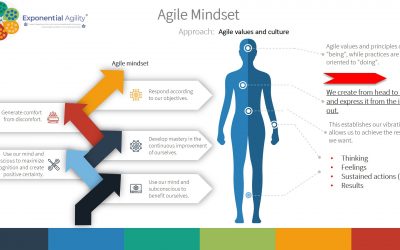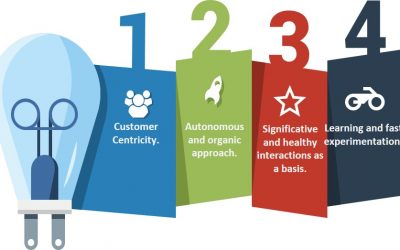
According to Wikipedia, the meaning of leadership highlights 3 fundamental elements, A) are managerial or directive skills, B) to influence people C) towards the achievement of a goal, likewise for the word servant we can find: 1) that focuses on developing people’s potential.
If we integrate these 2 meanings, we could say that servant leadership is:
“Those managerial or directive skills, to influence people, focusing mainly on the development of their potential through the creation of new skills and people sustained growth.”
With a service leadership approach, we grow through people, it is an acceptance of action and external achievement, for this, if we are consistent, it is necessary to focus first on ourselves, guide us, then serve and / or guide other people. So true leadership begins within us and extends to all of our spheres.
Leading ourselves involves creating an internal state of readiness for responsible action based on our circle of influence. It is an internal mental state, which has to do with our passion, our perspective and emotional balance, which prepares us to carry out visible, consistent public actions: our feelings determine, our thoughts, and these in turn guide and focus our energy and actions, in the long run it makes possible the results and their impact. If there is consistency and focus between our passion, emotions, thoughts, actions and results, our energy is focused.
Leading yourself will make you self-sufficient and self-aware, it is setting our goals, framing and developing our skills, it requires a self-management of the mindset, especially our behavior and our relationships, under a framework of integrity.
For this it requires 2 fundamental axes:
One and the most significant is passion: It is that purpose that is most relevant, that makes us feel stronger and has a positive impact on others, so that we are always fighting a battle, we will know what moves us and we will keep focused in that purpose and ultimate goal.
The other is motivation: It implies that we bring the emotional thermometer inside and it is not external, under this internal focus, our motivators are intrinsic, autonomy oriented, generating mastery and purpose. A tool that can help us to know what moves us are the management motivational meeting cards 3.0, if we apply it precisely to our person, we can first be aware of what moves us.
When we lead ourselves, it is necessary to take responsibility for our goals and our own development:
We require establishing strategic objectives to focus our energy. Remember, the results are the side effect of the habits we generate. So, this involves identifying opportunities to grow, strategic objectives and the key results to know what we are progressing. The constant definition of what we want to achieve and / or leverage now is a sign of strength.
This implies that we must change the language and internal dialogue regarding success and failure, recording that these are chronic states of learning. Now there are more achievement levels, one data point compared to the average achievement level in your performance. Prosperity is the product of the belief system.
Leading ourselves is also to be responsible for our performance evaluation system, we must constantly evaluate our emotional state, know our weaknesses, strengths and request feedback to contextualize our perspective. Let’s remember, that striving for perfection in everything can prevent us from being excellent in relevant things.
To create a resilient mindset, we have to create habits and celebratory habits, people with high levels of performance know how to recognize and reward themselves, the goal is to generate in turn the habit that good work creates pleasure for us. So, let’s mark our victories in terms of impact and coverage, not just action.
Leading yourself requires a support system and being aware of our circle of influence, we always ask ourselves, who are we? where are we? where do we want to go, have we asked the client? what is the current state? How far can we give? and who can help us? Seeking support and / or encouragement from our peers, leaders, and / or mentors will help us clarify our circle of influence and increase self-confidence.
Guiding oneself requires self-awareness and self-care, since we adapt and / or change our own behavior, so we move from reactive behavior, where the thermometer of our temperature is held by others, to an strategic and long-term thinking, where we have our temperature control, we have our own internal music.
Thus, we begin our journey to maturity by taking responsibility for our motivation, our resilience, and our rewards, allowing us to lead ourselves first and then others.
Bibliography:
- Avery, C. M. (2016). The responsibility process: Unlocking your natural ability to live and lead with power. Pflugerville, TX: Partnerwerks, Incorporated.
- Koestenbaum, P. (2010). Leadership: The inner side of greatness: A philosophy for leaders. San Francisco, CA: Jossey-Bass.
- Wiseman, L., & Tato, A. M. (2019). Multiplicadores: Cómo potenciar la inteligencia de tu equipo. Miami, FL: Penguin Random House Grupo Editorial.
- Koning, P. (2020). Agile leadership toolkit: Learning to thrive with self-managing teams. Boston: Addison-Wesley.
- JOHANSEN, B. (2017). NEW LEADERSHIP LITERACIES: Thriving in a future of extreme disruption and distributed everything. Place of publication not identified: READHOWYOUWANT COM.
- Blanchard, K. H., & Broadwell, R. (2018). Servant leadership in action: How you can achieve great relationships and results. Oakland, Ca: Berrett-Koehler ,, a BK Business book.
- Hamman, M., & Cooney, L. (2019). Evolvagility: Growing an Agile Leadership Culture from the Inside Out. Lopez Island, WA: Agile Leadership Institute.
- Peterson, J. (2020). Entrepreneurial leadership: The art of launching new ventures, inspiring others, and running stuff. Nashville: HarperCollins Leadership.
- Coriat, B., & Domínguez, R. A. (1992). Pensar al revés: Trabajo y organización en la empresa japonesa. México, D.F.: Siglo Veintiuno.



